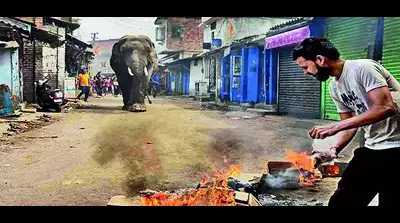A man was trampled to death by a herd of elephants on his way home from the market in Tripura. The incident, which occurred on Monday near Khowai district, has left the community reeling with shock and grief, while reigniting the debate on human-elephant conflict in the region.
The victim, identified as Niranjan Chowdhury, was a resident of Khowai, a quaint settlement nestled amidst the verdant landscapes of Tripura. Like any other day, he had ventured out to the local market, hoping to procure essentials for his family. Little did he know that his routine journey would end in tragedy, as he encountered a herd of elephants on the path back home.
Eyewitnesses recount the harrowing scene, describing how the peaceful tranquility of the forest was shattered by the trumpeting of elephants and the panicked cries of villagers. In a matter of moments, chaos ensued as the massive creatures, startled by human presence, charged towards the unsuspecting crowd. Despite attempts to flee, Niranjan found himself caught in the path of the stampeding elephants, unable to escape their wrath.
The aftermath of the incident was one of devastation and despair. Villagers rushed to the scene, desperate to rescue Niranjan from the clutches of the enraged elephants, but their efforts were in vain. By the time help arrived, it was too late, and Niranjan had succumbed to his injuries, leaving behind a grieving family and a community in mourning.
The tragedy highlights the complex and often perilous relationship between humans and elephants in regions where their habitats overlap. As human settlements encroach upon forested areas, conflicts between humans and wildlife become increasingly common, leading to tragic outcomes for both sides. In Tripura, where lush forests provide vital habitats for elephants, such encounters are not uncommon, posing a constant threat to human safety.
Efforts to mitigate human-elephant conflict have been ongoing, with authorities implementing various measures such as the creation of elephant corridors and the establishment of early warning systems. However, the challenge remains formidable, requiring a delicate balance between conservation efforts and the needs of local communities.
In the wake of this tragic incident, there is a renewed call for comprehensive strategies to address human-elephant conflict in Tripura and beyond. This includes not only the implementation of preventive measures but also initiatives aimed at raising awareness and fostering coexistence between humans and elephants. Education plays a crucial role in this regard, as communities must be equipped with the knowledge and tools to mitigate conflicts and minimize risks.
Furthermore, there is a pressing need for enhanced coordination between government agencies, wildlife experts, and local communities to develop holistic solutions that take into account the complex dynamics of human-elephant interactions. By working together, stakeholders can identify and implement strategies that promote the well-being of both humans and elephants, ensuring the peaceful coexistence of all parties involved.
As Niranjan’s family mourns their loss and the community grapples with the aftermath of the tragedy, there is a sense of urgency to prevent similar incidents from occurring in the future. Every life lost to human-wildlife conflict serves as a poignant reminder of the need for proactive measures to safeguard both human communities and vulnerable wildlife populations.
In honoring Niranjan’s memory, we must redouble our efforts to create a world where humans and elephants can coexist harmoniously, respecting each other’s space and sharing the land upon which we both depend. Only then can we ensure that tragedies like this one become a relic of the past, and future generations can enjoy the beauty and wonder of Tripura’s natural landscapes without fear or danger.




